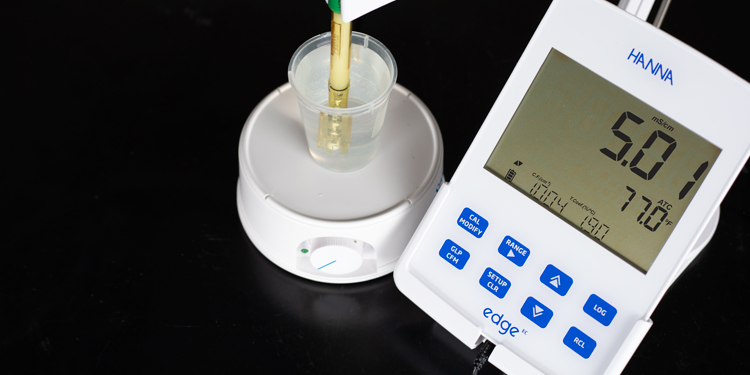 Could you be making mistakes during EC measurement?
Could you be making mistakes during EC measurement?
Electrical conductivity measurements are used every day to monitor everything from soil health, to electroplating, to the salinity level in fish tanks. With all of these measurements taking place, you have to wonder, am I testing properly? Or, How do I clean my EC probe? Over time, we at Hanna have found that there are 10 common mistakes when taking an EC measurement.
Here are our top 10 mistakes when taking an EC measurement.
Mistake #1: Improper probe submersion.

- Why - Incomplete submersion can cause erratic and/or inaccurate readings.
- Fix - Check that the vent hole is completely submerged on a four ring probe.
Mistake #2: Not using a plastic beaker.

- Why - Glass and metal can cause EMC interferences (electromagnetic interferences) with your EC probe readings.
- Fix - Use a plastic beaker, and keep probes at least an inch away from all sides of the beaker.
Mistake #3: Not rinsing your probe.

- Why - Salt build-up and other residues can contaminate samples and cause erratic readings.
- Fix - Always rinse the probe with deionized water before storage and after removing from storage. When calibrating:
a. Rinse the probe in deionized water.
b. Gently shake off the excess water from the probe.
c. Immerse the probe in a beaker or cup with some standard.
d. Swirl the probe and then remove it from the beaker.
e. Repeat steps c and d 3-5 times to "clean" the probe".
When taking a reading, the same steps should be taken, but replace the standard with extra sample in a clean beaker.
Mistake #4: Storing your probe incorrectly.

- Why - Some EC probes are combination (EC/pH) probes, and therefore the pH glass can dry out if stored improperly.
- Fix - You can “revive” dried out pH glass on a combination probe by submerging the probe in pH storage solution for at least one hour.
Mistake #5: Not cleaning your probe regularly.

- Why - Deposits on the probe can build-up over time on the electrode portion and the vent hole. This can cause erratic readings and issues calibrating.
- Fix - Use warm water with soapy surfactants and then rinse the probe thoroughly. Do not use cleaning solution or solvents as those can be chemically incompatible with the body of the probe.
Mistake #6: Calibration missteps.

- Why - All EC probes need to be calibrated for the greatest accuracy.
- Fix - A single or multi-point calibration can be used when calibrating an EC probe. If the probe is used daily, calibrate it daily. If not, calibrate the probe prior to use.
Mistake #7: Using old calibration standards.

- Why - Calibration standards have no buffering capacity and are easily contaminated.
- Fix - Always use fresh calibration standard and rinse your probe with deionized water and an extra beaker of standard for rinsing before calibrating. Have a separate beaker with some calibration standard or sample in it to quickly rinse the probe with before taking a measurement. This will help prevent contamination of standard, or sample.
Mistake #8: Leaving bubbles on a probe.

- Why - In four ring probes, air can become trapped inside the probes or stay on the surface of the probes when they are submerged. This can cause erratic or erroneous readings.
- Fix - Submerge the probe past the sleeve hole to fill the space around the probe. Carefully move the probe up and down in the sample and then gently tap the probe on the bottom of the beaker to dislodge bubbles.
Mistake #9: Having the wrong probe for your sample.

- Why - Not all EC probes can measure in every EC range, and some probes may not be ideal for all samples.
- Fix - Based on your sample choose a probe that can cover your measurement range. Check if the probe you want is compatible with your measurement style: do you need a stationary meter or something more portable?
Mistake #10: Not taking the time for a stable reading.

- Why - Even if a probe has integrated temperature compensation, it takes time for the probe to reach thermal equilibrium.
- Fix - Take an extra moment to ensure that the temperature and the EC reading has fully stabilized. This will help to ensure accurate readings.
Remember to: Clean Regularly, Calibrate Often, Care Always
Have questions?
Contact a Hanna Technical Specialist at sales@hannainst.com, the chat in the lower right-hand corner of the screen, or contact your local Hanna office.
Allison graduated from Bryant University with a Master’s Degree in Global Environmental Studies. She is passionate about nature, and how science is connected to the world around us. At Hanna, she provides an array of content and support to customers through the Hanna Blog, SOPs, and Data Sets.
Allison may be reached at ahubbard@hannainst.com.


